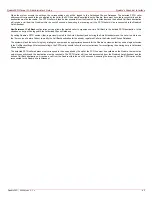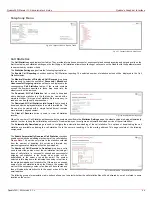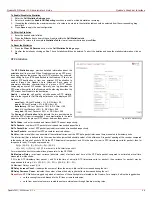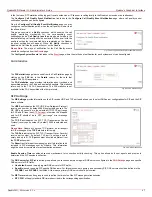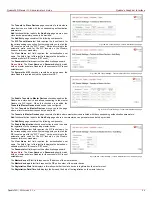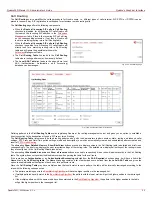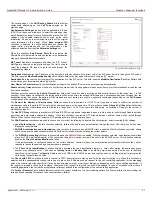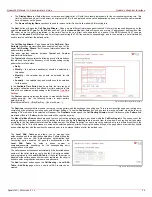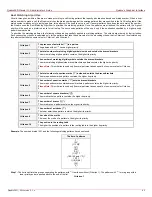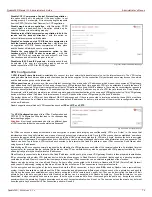
QuadroFXO Manual II: Administrator's Guide
Quadro's Graphical Interface
QuadroFXO; SW Version 5.1.x
56
The pattern in the highest position of the rearranged list will be considered as the preferred one. The second and subsequent matching patterns will
be used, if the destination refused the call due to the configured Fail Reason.
The Enable/Disable functional buttons are used to enable/disable the selected route(s). Disabled routes will have no effect. Enabled routes will be
parsed when initiating routing calls. The State column in the Call Routing Table displays the current state of the routes (enabled/disabled).
Add starts the Call Routing Wizard where a new routing pattern may be defined. The Call Routing Wizard is divided into several pages. Page 1
displays the following components:
The Enable checkbox is used to enable the newly created
routing rule. By default, this checkbox is selected, so the newly
created routing rule will be enabled. But if you wish to create a
routing rule for a later use, disable it from this page. The new
routing rule will be added to the Call Routing Table but will be
disabled and will not be considered when placing calls through
the call routing unless it is enabled again.
The Pattern text field specifies calls to which the rule should be
applied. If a call, either inbound or outbound, has a destination
number that matches the specified pattern, it will be completed
according to the current rule. A routing pattern may contain
wildcards. The complete list of characters and wildcards allowed
in this text field is given in the chapter
3
Wildcards
.
Number of Discarded Symbols (NDS) requires the number of
symbols that should be discarded from the beginning of the
routing pattern. The field should be empty if digits do not need to
be discarded. Only numeric values are allowed for this field,
otherwise the error message “Error: Number of Discarded
Symbols is incorrect - digits allowed only” will appear.
Fig. II-105: Call Routing Wizard - page 1
Prefix requires entering the symbols (letters, digits and any characters supported in the SIP username) that will be placed in front of the routing
pattern instead of the discarded digits. The following tags can be used for this field:
•
<callerid:range> - used to apply the complete or a part of caller ID (the caller’s number detected during the call) as a prefix. For example,
<callerid:1-3> indicates that the first 3 digits of the caller ID will be considered as a prefix, <callerid:3-end> indicates that the caller ID from its
3
rd
digit and up to the end will be applied as a prefix. This tag can be used in combination with other digits at the beginning or at the end, as well
as with wildcards.
•
<dialednum:range> - used to apply the complete or a part of dialed number (the number dialed by the caller to place a call) as a prefix. For
example, <dialednum:1-3> indicates that the first 3 digits of the dialed number will be considered as a prefix, <dialednum:3-end> indicates that
the dialed number from its 3
rd
digit and up to the end will be applied as a prefix. This tag can be used in combination with other digits at the
beginning or at the end, as well as with wildcards.
Suffix requires entering the symbols (letters, digits and any characters supported in the SIP username) that will be placed in the end of the routing
pattern. For example, if the routing Pattern is 12345, the Number of Discarded Symbols is two, and the Prefix is 909 and Suffix is 0a, the final
phone number will be 9093450a.
Call Type gives you the option to select the call type. The following call types are available:
•
PBX - local calls to Quadro’s extensions
•
PBX-Voicemail - calls directly to the voice mailbox of the local PBX extension
•
SIP – calls through a SIP server
•
IP-PSTN – calls through the IP-PSTN provider to the remove PSTN global telephone network
•
FXO – calls to a PSTN global telephone network
Metric allows entering a rating for the selected route in a range from 0 to 20. If a value is not inserted into this field, 10 will be used as the default. If
two route entries match a user’s dial string, the route with the lower metric will be chosen.
The Description text field requires an optional description of the routing pattern.
The Filter on Caller / Call Type / Modify Caller ID checkbox selection allows limiting the functionality of the current route to be used by the defined
caller(s) only. If this checkbox is enabled, inbound caller information (Inbound Caller Pattern, Inbound Call Type, Inbound Port ID, etc.) will be
required later in the Call Routing Wizard.
The Set Date / Time Period(s) checkbox selection allows you to define a validity period(s) for current routing patterns to take place and to define
pattern date/time rules. When this checkbox is enabled, the Call Routing Wizard - Page 5 will be displayed.
Require Authorization for Enabling/Disabling checkbox is used to enable administrator’s password authentication when enabler/disabler keys are
configured for the routing rule. The service can be used locally from the handset (see Feature Codes) or remotely from Auto Attendant (see Auto
Attendant Services). When this checkbox is selected, administrator’s password will be requested to enable/disable the certain routing rule(s). If the
administrator’s password has been inserted incorrectly for 3 times, no status changes will be applied to any of the routing record(s), even to those
which have no authorization enabled.
Enabler Key and Disabler Key text fields request digit combination which should be dialed from the handset or Auto Attendant to enable or disable
the certain routing rules in the Call Routing Table. You can set the same Enabler/Disabler Key for multiple routing rules (the same key may be used
as enabler for one routing rule, and as disabler for another one) - this will allow managing several routing rules with the single key.


